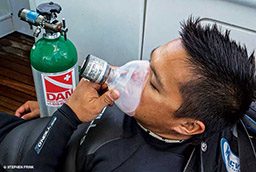In the crystal-clear waters of the tropical Pacific, our research team from the Baum Lab at the University of Victoria studies coral health and diversity to understand the future of reef ecosystems. We document the reef and conduct coral surveys on a remote and relatively undeveloped Pacific island. On a recent expedition, a seemingly small issue turned into an emergency that, if not for the support of DAN® and a great team, might have ended very differently.
We were surveying corals in 33 feet of seawater. This particular dive, which turned out to be our last that day, was different from others. I felt slow and unable to concentrate. I tried to count corals — four, five, six … what comes after six again? My brain felt foggy, and I slowly realized that something might be wrong.

After surfacing from a dive earlier that day my buddy had a slight headache. It went away quickly, so we attributed it to swimming against a strong current. But after we surfaced from our final dive I was certain something was wrong: I felt ill, and my buddy’s headache was back in full force. Our emergency response plan kicked into action. We headed back to shore, where one of our team members contacted DAN. My buddy and I began breathing emergency oxygen, and team members monitored our condition. Everyone prepared to enact the evacuation plan to fly us off the remote island if necessary.
Our primary symptoms subsided, and we were able to wait a week for the next scheduled flight off the island. We discovered that the most probable cause of our incident was carbon monoxide poisoning. Insidious low levels of carbon monoxide in our breathing gas, which came from an old, gasoline-powered compressor on the island, combined with repetitive dives over multiple days may have allowed carbon monoxide to build up in our bodies. While the risk of carbon monoxide contamination is very low when using modern compressors, it should never be ignored, especially in remote locations.
Prepared
Our team uses a variety of strategies to prevent and manage emergencies in the field:

- Emergency Response Plan. As scientific divers we are required to write an extensive dive plan in advance of our trip. Our plan covers emergency oxygen, nearby medical facilities, evacuation procedures and contact information for the U.S. Coast Guard and DAN. No matter what type of diving you do, it’s a good idea to put together a detailed emergency response plan before you dive in a new location.
- DAN Support. Immediate access to a DAN oxygen unit and the DAN Emergency Hotline (+1-919-684-9111) are essential elements of our emergency response plan. DAN supports our endeavors through the DAN Oxygen Grant Program, which provides research teams and other organizations that lack a reliable oxygen supply with a DAN oxygen unit that fits their needs. In addition to having a DAN emergency oxygen unit on site, DAN’s assistance over the phone helped our team make decisions about treatment and follow up throughout this incident.
- Diver Support. One of the most important skills when diving anywhere is knowing when to call off a dive. During this incident, as soon as one of the divers said, “I’m not OK,” diving operations came to an abrupt halt. When a diver has an objective, such as science or photography, it’s hard to admit that something’s wrong and stop work underwater. Calling off a dive is difficult, but it is absolutely vital to foster a team mentality that supports a diver’s decision to stay out of the water. Being honest with yourself and others about your symptoms can be the difference between “I am glad we stopped diving” and “If only we had stopped diving….”
Far Afield
People who have dived primarily in developed locations might not realize the additional risks present in less-developed areas. Here are a few recommendations for diving in remote locations:
- Investigate air quality. Ask the dive shop when their air was last evaluated by a certified testing laboratory. Consider learning to use and bringing air test kits with you; these range from simple color-changing sensors to electronic analyzers (see “When Gas Goes Bad” at AlertDiver.com/gas_analyzers). If a compressor looks so shabby or dirty that it makes you uncomfortable, don’t use it.
- Ensure emergency oxygen is available. Ask whether oxygen is available through the local dive operation, confirm there is a reliable way to administer it, and ensure there is enough to last for two or more divers to get to the closest medical facility.
- Be aware of cultural differences. When communicating with dive shops in countries other than your own, make sure you’re talking about the same things. Ask detailed, specific questions about dive safety so you know what resources will be available to you in the event of an emergency. If possible, learn about relevant cultural differences beforehand.
Safety measures are location specific. Just because a dive shop has a compressor doesn’t mean its tanks are safe for diving. When you’re off the beaten path, be vigilant in verifying tank inspections (visual and hydrostatic), testing air quality and watching for symptoms.
As for my dive partner and me, we made full recoveries, thanks to the quick assistance of our dive team and the professionals at DAN.
© Alert Diver — Q2 Spring 2015